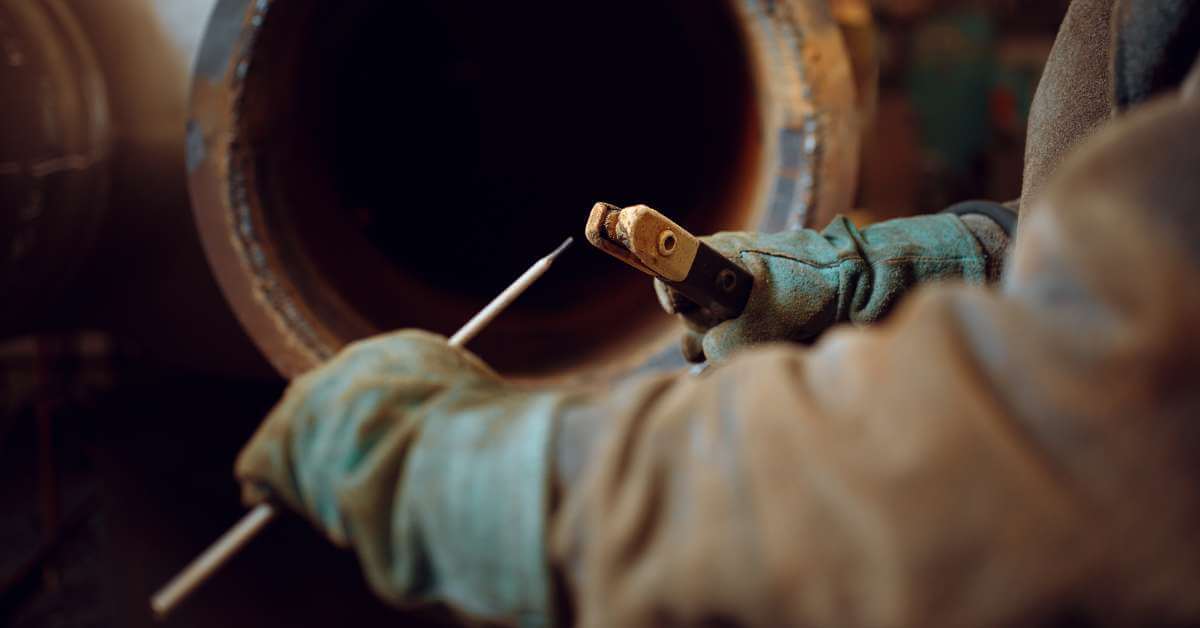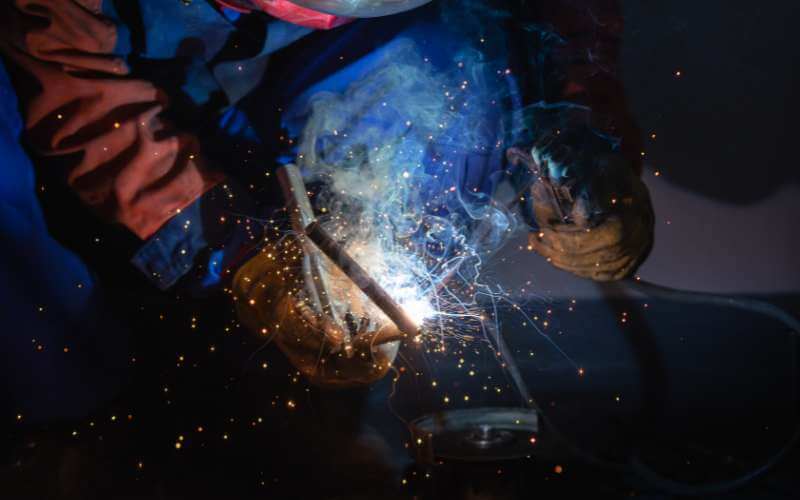When welding cast iron, selecting the appropriate cast iron welding rod is crucial to ensure successful outcomes. The welding rod you choose impacts the quality of your weld and should be selected with utmost care and consideration.
As you choose the ideal welding rod for cast iron, it’s essential to consider each available option’s characteristics. Your welding technique and experience should also be considered to ensure the best possible outcome.
This article will explore the key factors to consider when selecting a welding rod for cast iron welding. Understanding these factors is necessary to choose the best rod that aligns with your unique welding needs and yields the best results.
How to Weld Cast Iron?
Cast iron welding is the process of joining cast iron pieces together using different techniques and tools. Welding cast iron can be challenging due to its unique properties, like high carbon content and thermal expansion rate.
To achieve successful welds, selecting the appropriate welding rod, preparing the cast iron surface by cleaning it, and removing any rust or paint are important. Preheating the cast iron helps minimize thermal stress and the chances of weld cracking.
There are various options for welding rods when working with cast iron. Nickel alloy with high nickel content welding rods are designed for cast iron welding. These rods create welds that can be machined and help prevent heat stress and fusion line cracks.
Steel rods can also be used for welding cast iron, especially when working on heavy-duty applications such as engine blocks. However, steel rods may provide less of a color match with the original cast iron surface.
Choosing the suitable filler material is crucial for successful cast iron welds. The welding process should involve continuous and controlled heat input to avoid excessive thermal stress. Experienced welders may have their preferred techniques and tools based on their preferences and job requirements.
For more information, please read our article: How To Weld Cast Iron? Can You Weld it?
Properties of Cast Iron for Good Welds
Cast iron is a type of metal that can be challenging, yet it’s rewarding to weld due to its properties. Knowing the properties of cast iron is very important for successful welding.
Cast iron has a high carbon content, so it can be brittle and crack easily. Nevertheless, it’s known for its excellent thermal conductivity and heat retention.
The coefficient of thermal expansion for cast iron is low, which makes it susceptible to rupture due to heat stress. So, preheating the cast iron and applying proper welding techniques to lessen the risk of cracking is highly recommended.
Cast iron can have different compositions, including gray cast iron, white cast iron, and ductile iron, each with its characteristics.
Carbon Content or Alloy Content
When it comes to cast iron welding, one important aspect to consider is the material’s carbon content. Cast iron typically contains a high carbon content, usually between 2% and 4%. This carbon content is about 10 times higher than that steel.
The high carbon in the cast iron gives it unique properties, such as excellent wear resistance and high castability. However, it also poses challenges when it comes to welding. The presence of carbon leads to the formation of graphite flakes, which can weaken the weld and make it prone to cracks.
To overcome challenges, alloying materials such as chromium, molybdenum, copper, titanium, and vanadium can be added to cast iron. Such addition helps to stabilize the carbon in cast iron and minimize the formation of graphite flakes, these alloys also alter the grain structure to improve ductility and machinability.
Melting Point and Working Temperature Range
The melting point of cast iron “depends on the grade” ranges from 1150°C to 1600°C (2100°F~2900°F), which is lower than steel, making it more susceptible to heat-induced stress and cracking during welding. Therefore, it’s crucial to preheat the cast iron to around 1100°C (2000°F) before welding it to minimize the risk of cracks.
Preheating the cast iron helps to distribute the heat evenly, thus preventing localized heating and reducing thermal stress that can cause cracks. It’s recommended to preheat the cast iron by using methods like flame, induction, or resistance heating to provide a consistent and controlled heat source.
Hardness and Tensile Strength
Understanding cast iron’s hardness and tensile strength is crucial when welding it. Cast iron is known for its high carbon content, which makes the metal hard. However, the high carbon content also reduces its flexibility, making cast iron brittle and more prone to cracking.
Cast iron comes in different types, such as gray, white, and malleable cast iron. Gray cast iron is the most used; it has a particular microstructure that consists of graphite flakes embedded in a matrix of ferrite and pearlite. Grey cast iron has good weldability and is often used for welding applications.
White cast iron has a different microstructure with a higher carbon content and no graphite flakes. This type of cast iron is extremely hard and brittle, making it more challenging way to weld. Malleable cast iron, however, is a heat-treated type of cast iron that has improved weldability compared to white cast iron.
Understanding cast iron’s properties, hardness, and tensile strength is important to implement the appropriate welding techniques with the proper materials to ensure strong and durable welds.
Stick Welding Rod for Cast Iron
The type of welding rod you use depends on factors like the type of cast iron, carbon content, and welding process. Welding cast iron requires a specialized rod that can handle high temperatures and thermal expansion.
The most commonly used rod is the nickel rod, which has a high nickel content that creates strong and machinable welds. Nickel rods match cast iron’s color and heat input, resulting in high-quality welds.
Some professional welders use copper alloy electrodes, as they can provide excellent fusion and minimize the risk of weld cracks.
Before selecting a rod, consider the specific requirements of the cast iron surface and the type of iron being welded.
Nickel 99 and Nickel 55 (Nickel/Iron) Stick Welding Electrodes
Nickel/Iron Stick Welding Electrodes are designed specifically for welding cast iron. There are different types available, each with unique welding properties.
Nickel 99 Welding Rod (ENi-CI Electrode): Also known as pure nickel rods, this cast iron welding electrode is used for flat, horizontal, and vertical positions (all positions) with direct current “reverse polarity” or AC. It has lower strength than the ENiFe-Cl and lower weld metal ductility.
Nickel 99 offers excellent corrosion resistance and high-temperature strength. It is used to weld iron, steel, brass, copper, and other nickel alloys in applications that require maximum machinability of highly diluted filler metal.
However, it is not recommended for welding gray iron as it is too brittle. This electrode operates at low amperages and is best suited for malleable or ductile iron on small or thin cast iron parts.
Nickel 55 Welding Rod (ENiFe-CI Electrode): This cast iron welding rod is used in all welding positions with direct current “reverse polarity” or AC. It provides excellent tensile strength and yield strength for reliable and high-quality welds.
Nickel 55 produces welds with excellent machinability. The welds also have a gray appearance that is visually appealing. Nickel 55 welding rod is cheaper than pure nickel rods (Nickel 99).
This electrode is ideal for welding ornamental castings and is recommended for welding ductile and malleable cast iron and some gray iron. It best suits thick sections and highly restrained weldments, high-strength and engineering cast iron grades, and welding cast iron to steel.
Both Nickel 99 and Nickel 55 electrodes are easy to use and offer excellent fusion and control of the weld pool. They have special flux coatings that aid in the welding process. These coatings generate a weld pool with controlled cooling to prevent cracking and promote fusion line integrity.
Top Cast Iron Electrodes
When welding cast iron, choosing the right brand and manufacturer is crucial for achieving strong and long-lasting welds. Here are some options offering a range of high-quality cast iron electrodes specifically designed for various applications and welding techniques.
Nickel 99 Welding Rod (ENi-CI Electrode)
No products found.
Nickel 55 Welding Rod (ENiFe-CI Electrode)
No products found.
FAQs about the Best Welding Rod for Welding Cast Iron
Many people have common concerns and questions about the best methods and suitable welding rods to use when welding cast iron. Here are some frequently asked questions and their answers:
What is the recommended welding rod for cast iron?
The recommended type of welding rod suitable for cast iron depends on the specific application and the type of cast iron being welded.
Nickel and nickel alloy electrodes are often recommended for their ability to prevent cracks and ensure maximum adhesion between the base metal and the weld.
Can I use a regular electrode for welding cast iron?
Yes, you can use a regular welding rod for cast iron, but it might not give you the perfect results. Welding cast iron requires a specific type of welding rod designed to handle the challenges of this material. Using the wrong rod can result in weak welds or even further damage.
It’s important to understand the different types of cast iron and choose the appropriate welding rod for each one. Additionally, alternative methods, such as brazing or using nickel-based rods, can be used for repairing cast iron.
Can I use MIG / TIG Welding for cast iron?
While MIG welding, also known as Gas Metal Arc Welding (GMAW), can be used for certain types of cast iron, there are better methods than this one. Cast iron has a higher carbon content, which can lead to cracking when exposed to the high heat input of MIG welding. However, specialized MIG welding machines and techniques can be used for specific cast iron applications.
TIG welding, or Gas Tungsten Arc Welding (GTAW), can be used for welding cast iron. TIG welding offers precise control over the arc process, making it suitable for working with the delicate nature of cast iron. However, you must follow proper sequence and procedure when using a TIG welder for cast iron.
Can cast iron be welded or brazed?
Yes, cast iron can be welded or brazed. Welding involves melting the base metal and the welding rod to create a fusion line, while brazing uses a filler material with a lower melting point to join the cast iron pieces.
Both welding and brazing require careful preparation, including cleaning the cast iron surface and removing any foreign material or oxidation.
Conclusion
In conclusion, choosing the right welding rod and technique is essential for successful cast iron welding. Nickel and nickel alloy electrodes are often recommended for their ability to prevent cracks and ensure strong adhesion.
Understanding the impact of factors like heat stress and fusion line cracks can also improve welding processes. The right approach makes achieving high-quality and long-lasting welds in cast iron projects attainable.






